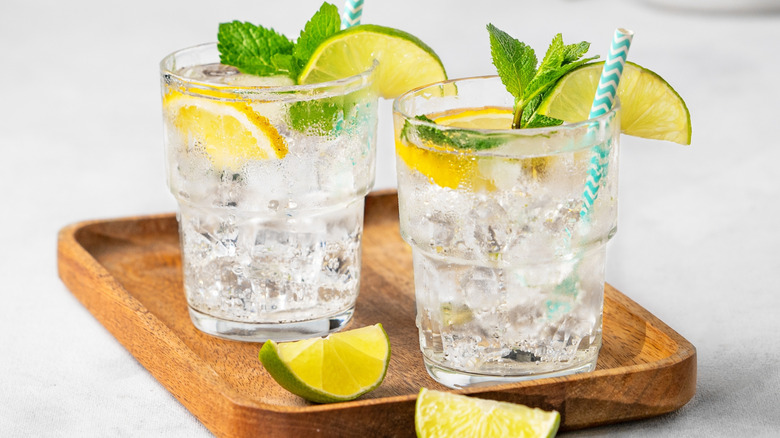Why Does Tonic Water Taste Like That?
Tonic water has become synonymous with "the thing you mix with gin." It's a bitter, carbonated beverage that a lot of people find off-putting when drunk solo. Its bitterness comes from a compound called quinine. Quinine is derived from the bark of the cinchona tree – a shrub-like tree indigenous to South America and particularly prevalent in tropical forests near the Andes Mountains.
It appears that people have varying levels of tolerance for quinine's bitterness, with research suggesting that some folks experience it as intolerably bitter while others find that taste notable but pleasant. Regardless, if you've ever accidentally cracked open a tonic water expecting a seltzer or club soda, you'd definitely be able to tell. Interestingly, today's tonic waters are nothing like what they used to be. They now contain far less quinine than in the original recipes that date back to the 1850s. Couple that with the fact that most commercial products contain around 30 grams of sugar per serving, and today's tonic waters seem downright sweet.
The quinine in tonic water was once commonly used to prevent and treat malaria. But since we now have other treatments that function better than quinine, as well as fever medications that work well (thank you, ibuprofen), why do we still add it to sparkling water? It turns out, this liquor and soda pairing just tastes amazing, and that's not just because of chance. The flavor compounds in gin and quinine actually bind together, creating what chemists call an aggregate. This aggregate means that the molecules from gin botanicals (like juniper, which is spicy and piney) and bitter quinine form together to create something unique — something greater than the sum of its parts.
The history of quinine goes back further than you think
Quinine-rich cinchona bark was used by European colonizers as early as the beginning of the 17th century to help alleviate fevers. However, the people indigenous to the Andes region — such as the Cañari and the Quechua — had known about the medicinal uses of cinchona bark long before then. Europeans began experimenting with various formulas containing cinchona bark to treat malaria in colonized lands and back in Europe, but quinine itself was not isolated and synthesized until 1820. Subsequently, it was used successfully by Europeans as a malaria preventative for the first time in 1854. It was an incredibly important medicine. Whoever controlled the quinine controlled the universe — erm, I mean, controlled the only medicine available to help various Europeans colonize the tropics without dying.
As for the ever-famous gin and tonic cocktail, it was never intended for use as medicine. While quinine alone was treated as medicinal, even the Victorians weren't slamming down gin and tonics and expecting them to cure their malaria. In fact, tonic water and gin were usually thought of as a way to aid digestion, help Europeans tolerate the hot weather, and perhaps calm a fever, though tonic water wouldn't really have done anything more than simply taste refreshing. Imagine leaving cold, wet England for a tropical locale — you'd probably think you were dying of fevers day in and day out.

